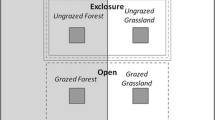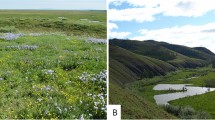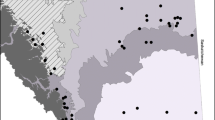Abstract
A prairie dog (Cynomys ludovicianus) colony with a known history of habitation was studied to quantify the effects of herbivory on plant species composition, dominance, stature and diversity in a North American mixedgrass prairie. Gradient analysis was used to quantify the relationship between plant community structure, prairie dog density, burrow density and habitation history and to document community-level responses of plants subjected to heavy grazing pressure. The results quantify the type, rate and extent of change which plant populations and communities may undergo in response to the differential grazing of plants variously tolerant of defoliation.
Detrended correspondence analysis indicated that 69% of the between-sample floristic variance on the site was attributable to prairie dog habitation. Perennial grasses were rapidly displaced from the site within 3 yr of colonization and were replaced by annual forbs. The net result was an increase in species richness and diversity on the prairie dog colony. Within the colony, however, the number of species was more a function of stand size than colonization history.
Significant decreases in canopy stature after 2 yr of habitation resulted from replacement of mid-height grass species by shortgrass species and forbs. In addition, there was a shift from tall growth forms of off-colony species to dwarf growth forms of the same species on the colony. Decreases in litter and increases in bare soil cover were substantial during the first 2 yr of habitation but changed little thereafter.
Similar content being viewed by others
Abbreviations
- WCC:
-
Wind Cave Canyon
- DCA:
-
Detrended Correspondence Analysis
References
Archer S. & Detling J. K., 1984. The effects of defoliation and competition on regrowth of tillers of two North American mixed-grass prairie graminoids. Oikos 43: 351–357.
Archer S. & Detling J. K., 1986. Evaluation of potential herbivore mediation of plant water status in a North American mixed-grass prairie. Oikos 47: 287–291.
Archer S. & Tieszen L., 1980. Growth and physiological responses of tundra plants to defoliation. Arctic Alpine Res. 12: 531–552.
Bakker J. P., 1985. Impact of grazing on plant communities, plant populations, and soil conditions in salt marshes. Vegetatio 62: 391–398.
Bonham C. D. & Lerwick A., 1976. Vegetation changes induced by prairie dogs on shortgrass range. J. Range Manage. 29: 221–225.
Chapin F. S. & Shaver G. R., 1985. Individualistic growth response of tundra plant species to environmental manipulations in the field. Ecology 66: 564–576.
Collins S. L. & Barber S. C., 1985. Effects of disturbance on diversity in mixed-grass prairie. Vegetatio 64: 87–94.
Coppock K. L., Detling J. K., Ellis J. E. & Dyer M. I., 1983a. Plant-animal interactions in a North American mixed-grass prairie. I. Effects of black-tailed prairie dogs on intraseasonal aboveground plant biomass and nutrient dynamics and plant species diversity. Oecologia 56: 1–9.
Coppock D. L., Ellis J. E., Detling J. K. & Dyer M. I., 1983b. Plant-herbivore interactions in a North American mixed-grass prairie. II. Responses of bison to modification of vegetation by prairie dogs. Oecologia 56: 10–15.
Detling J. K. & Painter E. L., 1983. Defoliation responses of western wheatgrass populations with diverse histories of prairie dog grazing. Oecologia 57: 65–71.
Fagerstone F. A., Tietjen H. P. & Williams O., 1981. Seasonal variation in the food habits of black-tailed prairie dogs. J. Mammal. 62: 820–824.
Garrett, M. G., 1982. Dispersal of black-tailed prairie dogs in Wind Cave National Park, S.D.M.S. Thesis. Iowa State University, Ames.
Garrett M. G., Hoogland J. L. & Franklin W. L., 1982. Demographic differences between an old and new colony of blacktailed prairie dogs (Cynomys ludovicianus). Am. Midl. Nat. 108: 51–59.
Gross K. L. & Werner P. A., 1982. Colonizing abilities of perennial plant species in relation to ground cover: implications for their distributions in a successional sere. Ecology 63: 921–931.
Hansen R. M. & Gold I. K., 1977. Blacktail prairie dogs, desert cottontails, and cattle tropic relatins on shortgrass range. J. Range Manage. 30: 210–214.
Harper, J. L., 1969. The role of predation in vegetational diversity. In: Diversity and stability in ecological systems. Brookhaven Symp. Biol. 22: 48–62.
Huston M., 1979. A general hypothesis of species diversity. Am. Nat. 113: 81–101.
Hill M. O., 1979. DECORANA — a FORTRAN program for detrended correspondence analysis and reciprocal averaging. Cornell Univ., Ithaca, N.Y.
Ingham R. E. & Detling J. K., 1984. Plant-herbivore interactions in a North American mixed-grass prairie. III. Soil nematode populations and root biomass dynamics on Cynomys ludovicianus colonies and adjacent uncolonized areas. Oecologia 63: 307–313.
Jaksic F. M. & Fuentes E. R., 1980. Why are native herbs in the Chilean mattoral more abundant beneath bushes: microclimate or grazing? J. Ecol. 68: 665–669.
Jones R. M. & Mott J. J., 1980. Population dynamics in grazed pastures. Trop. Grassl. 14: 218–224.
King, J. A., 1955. Social behavior, social organization, and population dynamics in a black-tailed prairie dog town in the Black Hills of South Dakota. Contrib. Lab. Vertebr. Biol., Univ. Mich. No. 67.
Kirk R. E., 1968. Experimental design: procedures for the behavioral sciences. Brooks/Cole Publ. Co., Belmont, Calif.
McNaughton S. J., 1983. Serengeti grassland ecology: the role of composite environmental factors and contingency in community organization. Ecol. Monogr. 53: 291–320.
McNaughton S. J., 1984. Grazing lawns: animals in herds, plant form and co-evolution. Am. Nat. 124: 863–886.
McNeilly T., 1984. Ecotypic differentiation in Poa annua: within population variation in response to competition and cutting. New Phytol. 96: 307–316.
Nie N. H., Hull C. H., Jenkins J. G. & Bent D. H., 1975. SPSS: statistical package for the social sciences. McGraw Hill Book Co., New York.
O'Meillia M. E., Knopf F. F. & Lewis J. C., 1982. Some consequences of competition between prairie dogs and beef cattle. J. Range Manage. 35: 580–585.
Peet R. K., 1974. The measurement of species diversity. Ann. Rev. Ecol. Syst. 5: 285–307.
Quinn J. A. & Miller R. V., 1967. A biotic selection study utilizing Muhlenbergia montana. Bull. Torrey Bot. Club 94: 423–432.
van Bruggen T., 1976. The vascular plants of South Dakota. Iowa State University Press, Ames.
Whittaker, R. H., 1970. Communities and ecosystems. MacMillan Publ. Co.
Author information
Authors and Affiliations
Rights and permissions
About this article
Cite this article
Archer, S., Garrett, M.G. & Detling, J.K. Rates of vegetation change associated with prairie dog (Cynomys ludovicianus) grazing in North American mixed-grass prairie. Vegetatio 72, 159–166 (1987). https://doi.org/10.1007/BF00039837
Accepted:
Issue Date:
DOI: https://doi.org/10.1007/BF00039837




